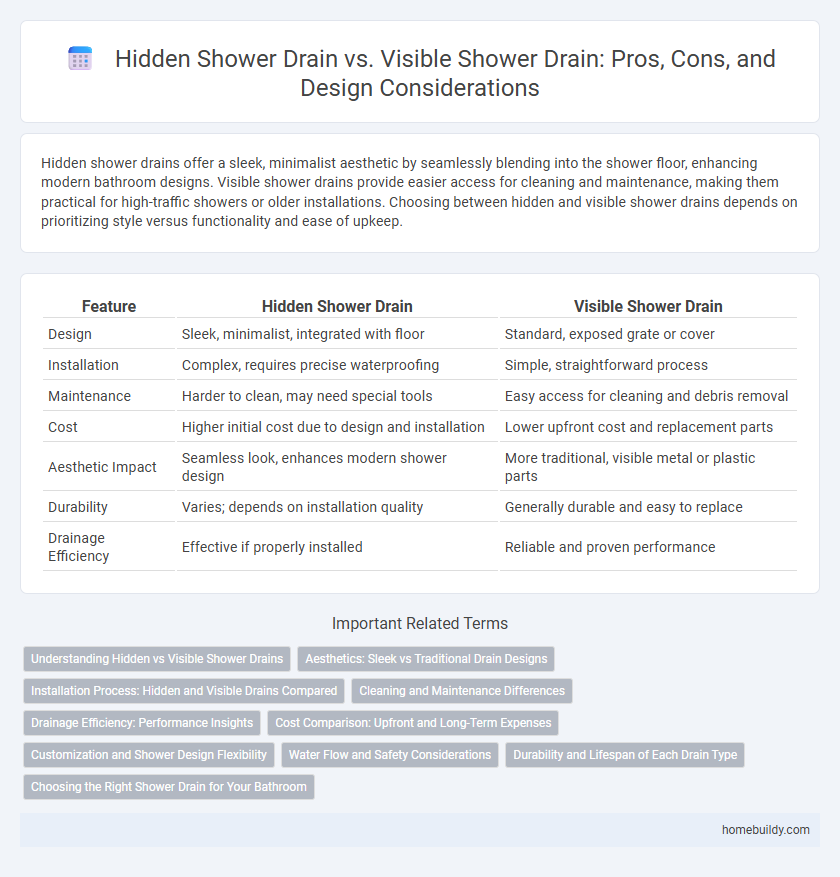Hidden shower drains offer a sleek, minimalist aesthetic by seamlessly blending into the shower floor, enhancing modern bathroom designs. Visible shower drains provide easier access for cleaning and maintenance, making them practical for high-traffic showers or older installations. Choosing between hidden and visible shower drains depends on prioritizing style versus functionality and ease of upkeep.
Table of Comparison
| Feature | Hidden Shower Drain | Visible Shower Drain |
|---|---|---|
| Design | Sleek, minimalist, integrated with floor | Standard, exposed grate or cover |
| Installation | Complex, requires precise waterproofing | Simple, straightforward process |
| Maintenance | Harder to clean, may need special tools | Easy access for cleaning and debris removal |
| Cost | Higher initial cost due to design and installation | Lower upfront cost and replacement parts |
| Aesthetic Impact | Seamless look, enhances modern shower design | More traditional, visible metal or plastic parts |
| Durability | Varies; depends on installation quality | Generally durable and easy to replace |
| Drainage Efficiency | Effective if properly installed | Reliable and proven performance |
Understanding Hidden vs Visible Shower Drains
Hidden shower drains offer a sleek, minimalist design by concealing the drainage system beneath the floor, enhancing bathroom aesthetics while maintaining efficient water flow. Visible shower drains, typically made of stainless steel or chrome, provide easy access for cleaning and maintenance but may disrupt the seamless look of modern showers. Selecting between hidden and visible shower drains depends on balancing design preferences with functional requirements like accessibility and installation complexity.
Aesthetics: Sleek vs Traditional Drain Designs
Hidden shower drains create a sleek, modern look by seamlessly integrating into the shower floor, enhancing minimalist bathroom aesthetics. Visible shower drains offer traditional designs that can complement classic or rustic styles but may disrupt visual flow with their prominence. Choosing between hidden and visible drains depends on the desired balance between contemporary elegance and conventional charm in bathroom design.
Installation Process: Hidden and Visible Drains Compared
Hidden shower drains require precise alignment within the subfloor and waterproof membrane during installation, ensuring seamless integration that prevents water leakage and maintains aesthetic appeal. Visible shower drains, generally easier to install, typically involve standard floor drilling and surface mounting, allowing for straightforward access during maintenance or replacement. The installation complexity of hidden drains often results in higher labor costs and longer project timelines compared to the simpler, more flexible installation of visible shower drains.
Cleaning and Maintenance Differences
Hidden shower drains require less frequent cleaning due to their concealed design, which minimizes hair and debris accumulation on the surface but can make deep cleaning more challenging and time-consuming. Visible shower drains offer easier access for routine maintenance, allowing quick removal of blockages and visible buildup but tend to collect hair and grime more readily, necessitating more frequent cleaning. Choosing between hidden and visible drains impacts maintenance strategies, with hidden drains emphasizing periodic, thorough cleaning and visible drains demanding regular, surface-level upkeep to prevent clogs.
Drainage Efficiency: Performance Insights
Hidden shower drains are engineered to optimize water flow by integrating seamlessly into the shower floor, reducing water pooling and improving overall drainage efficiency. Visible shower drains often feature larger surface areas and simpler designs that facilitate easier maintenance but may be less effective at directing water quickly toward the drain. Performance comparisons reveal hidden drains typically provide superior water evacuation rates and reduced clogging risks, enhancing long-term shower functionality.
Cost Comparison: Upfront and Long-Term Expenses
Hidden shower drains typically involve higher upfront costs due to specialized installation and waterproofing requirements, whereas visible shower drains are generally more affordable to install with standard plumbing setups. Long-term expenses for hidden drains may increase if repairs demand partial tile removal or intricate access, while visible drains allow easier maintenance and lower repair costs over time. Choosing between the two depends on balancing initial investment with potential future expenses linked to accessibility and durability.
Customization and Shower Design Flexibility
Hidden shower drains offer superior customization options by seamlessly integrating into various tile patterns and shower floor slopes, allowing designers to achieve a sleek, minimalist aesthetic without compromising drainage efficiency. Visible shower drains provide flexible installation choices with a range of grate styles, finishes, and materials, enabling tailored design expressions that complement diverse bathroom themes. Both types enhance shower design flexibility, but hidden drains excel in creating uninterrupted surfaces, while visible drains emphasize decorative details.
Water Flow and Safety Considerations
Hidden shower drains offer a sleek design that facilitates smooth water flow by minimizing surface disruption and preventing debris buildup, reducing the risk of clogs. Visible shower drains provide easy access for cleaning and inspection, enhancing safety by allowing quick identification of blockages or drainage issues. Choosing between hidden and visible drains impacts water evacuation efficiency and maintenance safety, making it essential to balance aesthetics with functionality.
Durability and Lifespan of Each Drain Type
Hidden shower drains typically offer enhanced durability due to their protection from external impacts and corrosion, often crafted from stainless steel or high-grade materials that resist wear over time. Visible shower drains, while easier to maintain and replace, may be more exposed to damage and corrosion, potentially reducing their lifespan if made from lower-quality materials. Both drain types can achieve long lifespans when maintained properly, but hidden drains generally provide a more robust solution for longevity in wet environments.
Choosing the Right Shower Drain for Your Bathroom
Choosing the right shower drain depends on bathroom aesthetics and functionality, with hidden shower drains offering a sleek, modern appearance by blending seamlessly with floor tiles while preventing clogs more efficiently. Visible shower drains, often made of stainless steel or chrome, provide easier access for maintenance and are ideal for traditional or industrial bathroom designs. Consider water flow capacity, ease of cleaning, and overall design harmony when selecting between hidden and visible shower drains for optimal bathroom performance.
Hidden shower drain vs visible shower drain Infographic

 homebuildy.com
homebuildy.com